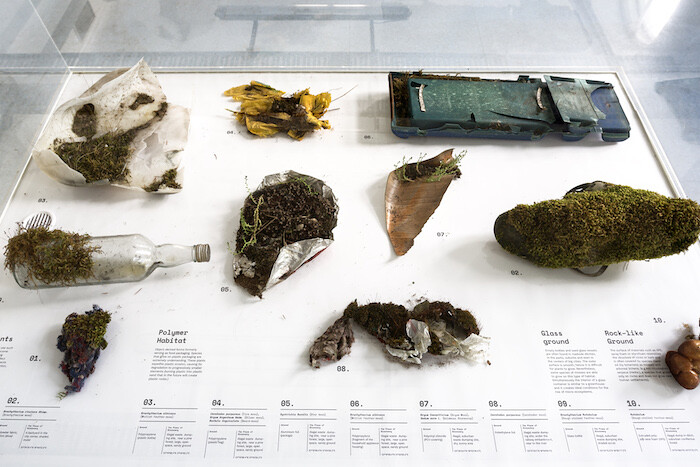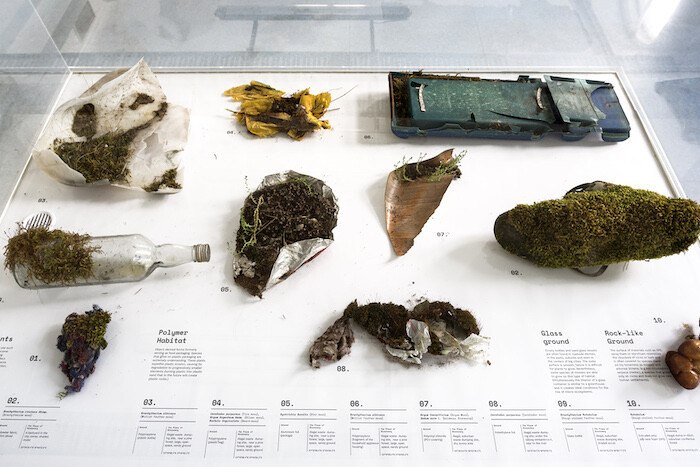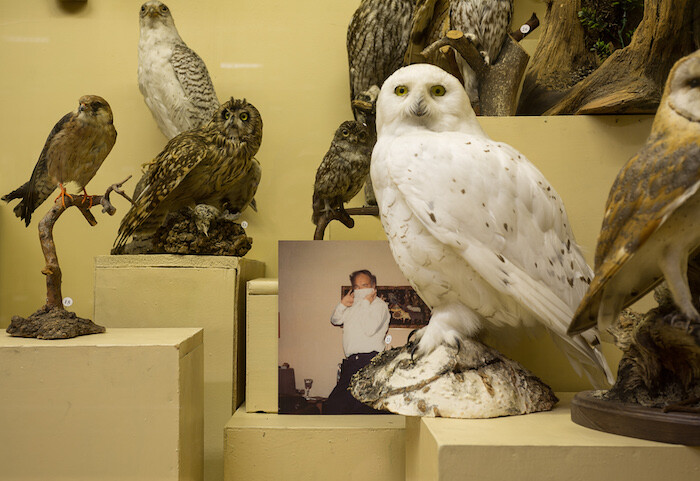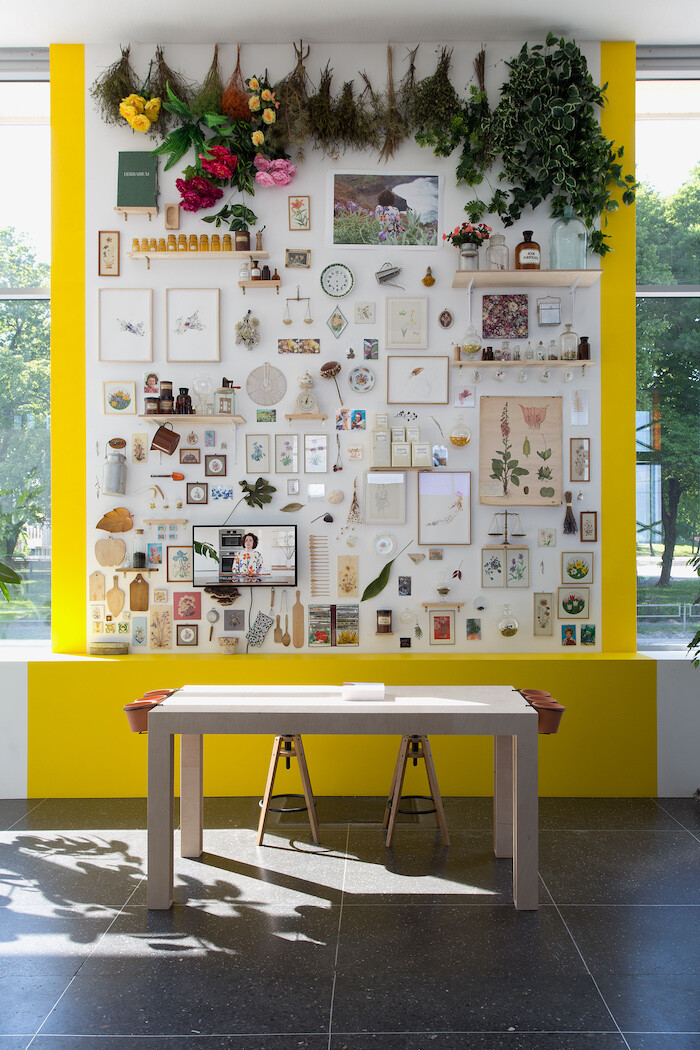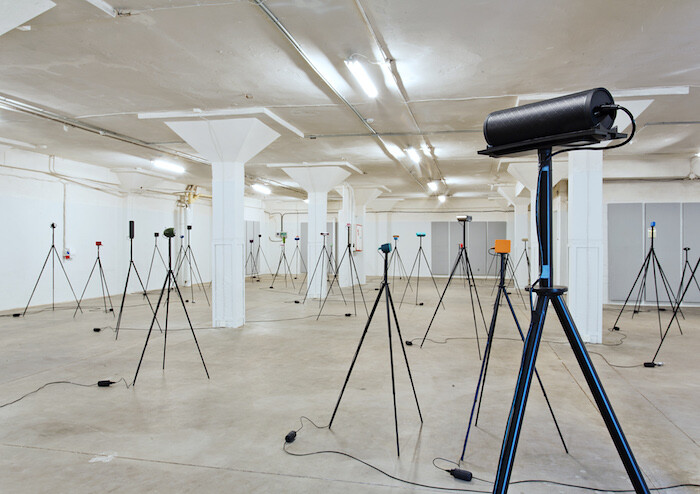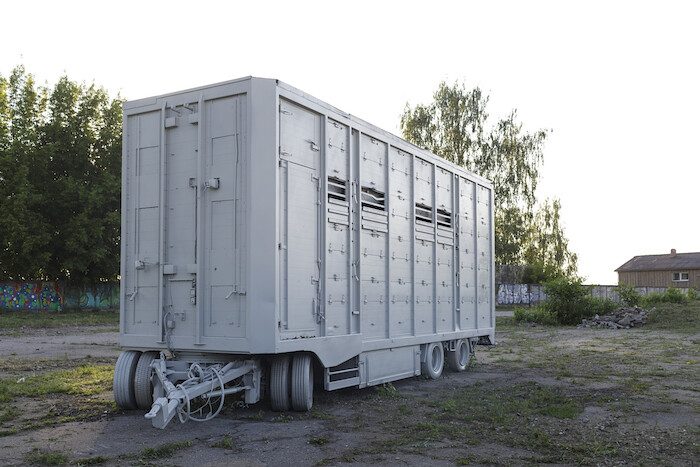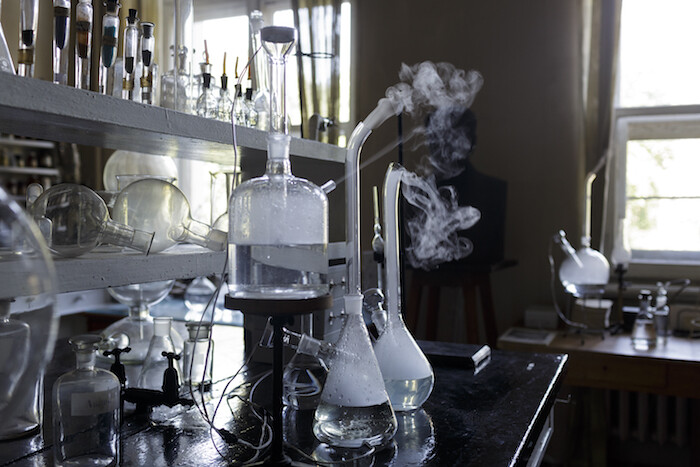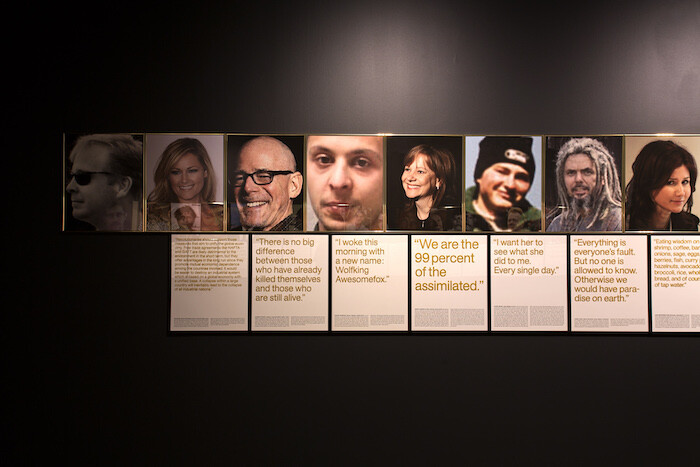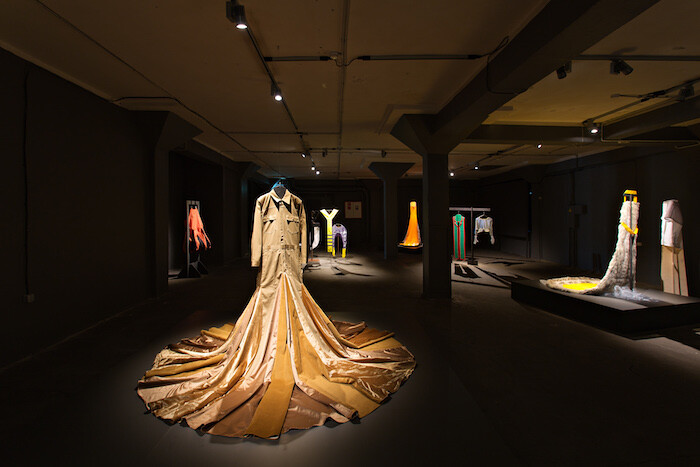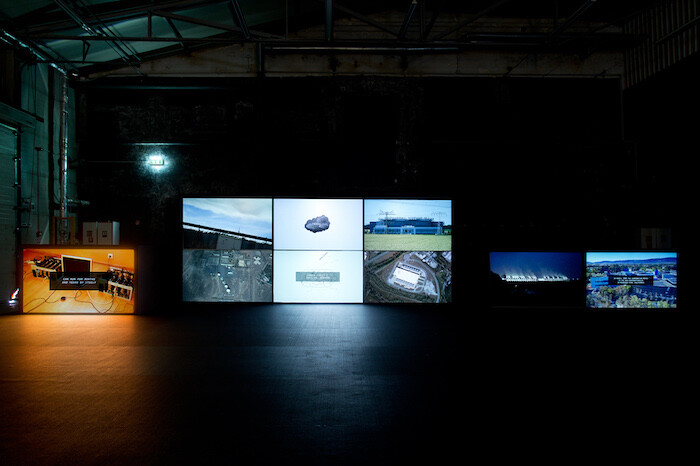The inaugural edition of the Riga International Biennial of Contemporary Art (RIBOCA) presents work by 104 artists with the intention of “taking the temperature of the human condition at the present moment.”1 The Anthropocene looms appropriately large, as do capitalism, technology, migration, work, time, identity (be it individual, regional, or global), and Latvia’s post-Soviet history. Diana Lelonek’s installation Centre for Living Things (2016–18) touches on nearly all these concerns. Displayed like laboratory specimens in a series of vitrines is a selection of discarded, human-made objects, now home to various vegetal life forms. Lichen covers a baby’s boot, feather moss grows from an old paint roller, more moss grows among the bright wires of a discarded circuit board, and so on. Lelonek has collected these objects from the edgelands beloved of the psychogeographers—“an illegal waste dumping ground near a pine forest,” reads one accompanying label—grouped them under invented categories, and listed the names of the minerals and plant species.
In assembling these hybrid forms that are neither simply natural nor artificial, Lelonek highlights the wastefulness of consumerism and speculates on possible environmental futures. The approach feels apt given the installation’s setting in the University of Latvia’s former biology faculty. This grand neo-Renaissance structure, built in 1898, is a maze of staircases, laboratories, offices, and auditoriums. Walls are hung with portraits of the institution’s (mostly male) former dignitaries while its corridors are lined with cabinets of butterflies, geological specimens, taxidermy, and elaborate scientific equipment. Lelonek’s installation—which mimics this institutional mania for collecting and categorizing—appears alongside numerous similarly preoccupied works: A Tour of The Dark Museum (2018), a museum-themed installation by Mark Dion; Zero Point Energy (2016), Kerstin Hamilton’s video about an atomic research laboratory; and beyond SE(A)nse: Smellers Corner (2018) by Sissel Tolaas, featuring nine glass vessels containing odors inspired by the Baltic Sea.
The faculty is one of eight RIBOCA venues, including disused docks, a peeling apartment, and the overgrown grounds of a vast, disused textile factory. Locals may already be aware of several of these locations—the arts festival Survival Kit took place at the biological faculty last year—but for visitors it’s refreshing to see RIBOCA steer away from the medieval town center and the famous Art Nouveau buildings further north and focus instead on Riga’s lesser-known places. But the venues’ unique histories present challenges for RIBOCA’s chief curator Katerina Gregos.
Gregos’s response has been to forge strong connections between art and place, meaning the thematic focus of each venue stems from the site itself. The majority of works in the peeling apartment, for example, offer intimate investigations of time and history. Kristaps Epners’s video installation Forget Me Not (2018) takes as its starting point correspondence sent in the 1970s by Latvian poet Miervaldis Kalniņš detailing his journey through Siberia. The work offers fascinating sketches of national and personal identity under communism.
Amid crumbling dock-side concrete, weeds, and graffiti—exactly the kind of wasteland in which Lelonek might discover riches—stands Jevgeni Zolotko’s The Sacrifice (2018), a gray trailer for carrying livestock reminiscent of those in which Latvians were transported to Siberia during mass deportations under Joseph Stalin. The trailer emits disconcerting banging noises, but it is unclear whether animals or humans are trapped inside: a confusion that deftly evokes the cruelty with which humans treat each other and other species. Located outside in the industrial port area of Andrejsala, it is one of several works to explore borders and migration. In Karel Koplimets’s photography and video installation Case No. 11. Talsinki (2016/18), Estonian laborers head to work on the Helsinki-Tallinn ferry while Finns head the opposite direction to fill their suitcases with cheap booze. Transitions of a different kind are explored in a nearby former cork factory. Sven Johne’s Anomalies of the early 21st century / Some case studies (2015) comprises 66 wall-mounted short stories—some fictional, others based on real people—illustrated with portrait photographs sourced online: a record-breaking German swimmer who retired at 24 to open an ice cream parlor, a Polish TV editor who went to live in the woods.
A highlight arrives in the adjacent galleries in Sporta iela 2, another old industrial building. In the first gallery is Hannah Anbert’s Sacred Work Fashion Collection (2016–18), a series of glamorous but useless workwear prototypes—a floor-length, fur-trimmed yellow neoprene apron, for example—exhibited on pedestals. Next door is Taus Makhacheva’s Dear R., R., K., S., M., A., C., S., K., I., G., L., A., A., L., P., G., E., J., D., M., C., B., O., F., F., R., D., M., E., L., I., F., L., A., M., T., K., K., L., P., F., V., A., L., L.. (2018), a room of numerous portable speakers of various brands and colors mounted on tripods, each whispering emailed apologies for late replies. The result is a gentle (and grimly familiar) cacophony. Side by side, the works wittily point to the sad absurdity of much modern labor. Labor of a more effective kind has taken place behind the scenes to ensure harmonious relations between RIBOCA and the city’s existing art scene. The sensitivity with which Gregos responds to each venue further roots the biennial in Riga’s urban landscape, but there are moments—most notably in the biology faculty—when this approach becomes so narrow that one’s thoughts start to feel predetermined. RIBOCA foregrounds much-discussed contemporary concerns—science is the new religion, there is too much plastic in the seas, technology has changed our lives beyond recognition, and so on—but leaves the viewer wondering whether art is the best medium to hammer home such information. Might art be better placed to ask—as Latvian writer Nora Ikstena does in Soviet Milk, her novel of a mother and daughter living under Russian rule and its collapse—“What to do with the truth?”2 Art need not just depict the world. It can act, intervene, or imagine it anew.
RIBOCA1 catalogue, 741.
Nora Ikstena, Soviet Milk, trans. Margita Gailitis (London: Peirene Press, 2018), 132.
